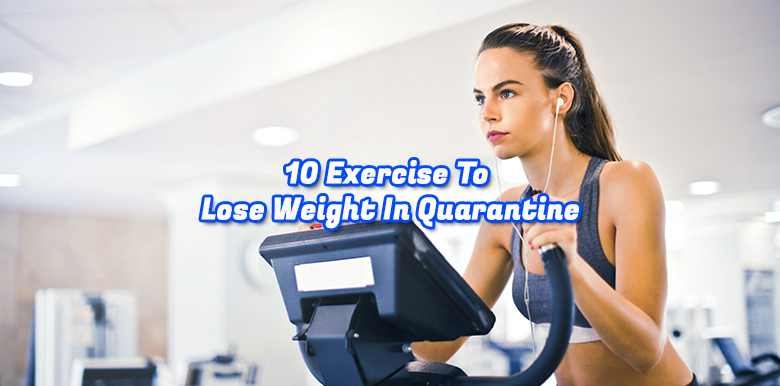Staying at home helps you take out time to stick to a workout routine. If you are trying to lose weight for a long time, then make the best use of this time. You need not go to gym or parks for this. All you need is a corner of your house where you have optimum space. It can either be your garden or your living room.
Advantages of exercise –
1. Help you control your weight – Along with diet, exercise plays an important role in controlling your weight and preventing obesity. To maintain your weight, the calories you eat and drink must equal the energy you burn. To lose weight, you must use more calories than you eat and drink.
2. Reduce your risk of heart diseases – Exercise strengthens your heart and improves your circulation. The increased blood flow raises the oxygen levels in your body. This helps lower your risk of heart diseases such as high cholesterol, coronary artery disease, and heart attack. Regular exercise can also lower your blood pressure and triglyceride levels.
3. Help your body manage blood sugar and insulin levels – Exercise can lower your blood sugar level and help your insulin work better. This can cut down your risk for metabolic syndrome and type 2 diabetes. And if you already have one of those diseases, exercise can help you to manage it.
4. Help you quit smoking – Exercise may make it easier to quit smoking by reducing your cravings and withdrawal symptoms. It can also help limit the weight you might gain when you stop smoking.
5. Improve your mental health and mood – During exercise, your body releases chemicals that can improve your mood and make you feel more relaxed. This can help you deal with stress and reduce your risk of depression.
6. Helps your mind sharpen – Helps to keep your thinking, learning, and judgment skills sharp as you age. Exercise stimulates your body to release proteins and other chemicals that improve the structure and function of your brain.
7. Strengthen your bones and muscles – Regular exercise can help kids and teens build strong bones. Later in life, it can also slow the loss of bone density that comes with age. Doing muscle-strengthening activities can help you increase or maintain your muscle mass and strength.
8. Reduce your risk of some cancers, including colon, breast , uterine, and lung cancer.
9. Reduce your risk of falls – For older adults, research shows that doing balance and muscle-strengthening activities in addition to moderate-intensity aerobic activity can help reduce your risk of falling.
10. Improve your sleep – Exercise can help you to fall asleep faster and stay asleep longer.
11. Increase your chances of living longer – Studies show that physical activity can reduce your risk of dying early from the leading causes of death, like heart disease and some cancers.
Easy exercise for beginners –
1. 20 Bodyweight squats – Stand with your hands on the back of your head and your feet shoulder-width apart with your feet turned out slightly to open the hip joint.
Lower your body until your thighs are parallel to the floor.
Pause, then return to the starting position.
Repeat.
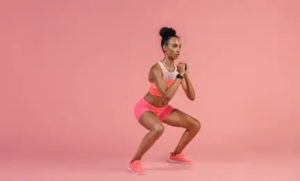
Squats
2. 10 Push-ups – Begin in a hands and knees position with your gaze at the floor.
Place your hands on the ground on either side of your shoulders. Your knees should be at a comfortable distance apart.
Inhale as you slowly lower your elbows to bring your chest toward the ground. Be sure to keep your core muscles contracted.
Pause for a second in the lowered position — your chin may lightly touch the ground.
Exhale as you push up from the ground to your starting position.
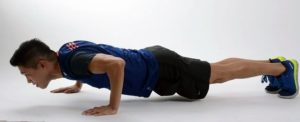
Push ups
3. 10 Walking lunges (each leg) – Stand tall in front of a long and clear walkway. Your feet should be hip-width apart, your chest up, and your core and glutes engaged. Take a big step forwards with your left foot, lowering until both your knees are bent at 90° and your front thigh is parallel to the floor.
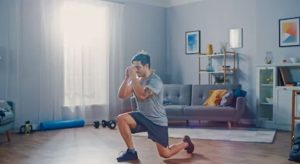
Lunges
4. 10 Dumbbell rows (with weights) – You need a bench or a sturdy thigh-high platform to lean on when doing the exercise, so secure that first and place a dumbbell on the floor to one side of it.
Put your left leg on the bench and grab the far side with your left hand, then bend over so your upper body is parallel with the ground.
Reach down and pick up the dumbbell in your right hand with a neutral grip (palm facing you), then hold it with your arm extended, keeping your back straight.
Bring the dumbbell up to your chest, concentrating on lifting it with your back and shoulder muscles rather than your arms.
Keep your chest still as you lift. At the top of the movement, squeeze your shoulder and back muscles.
Lower the dumbbell slowly until your arm is fully extended again. Do all your reps on one arm before switching to the other side.

Exercise with dumbbel
5. 15 Second Plank – Plant hands directly under shoulders (slightly wider than shoulder width) like you’re about to do a push-up.
Ground toes into the floor and squeeze glutes to stabilize your body. Your legs should be working, too — be careful not to lock or hyper extend your knees.
Neutralize your neck and spine by looking at a spot on the floor about a foot beyond your hands. Your head should be in line with your back.
Hold the position for 20 seconds. As you get more comfortable with the move, hold your plank for as long as possible without compromising your form or breath.
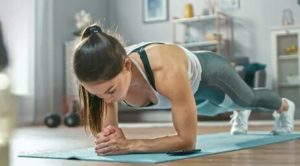
Plank
6. 30 Jumping jacks – Start standing up with your legs together, a slight bend in knees, and hands resting on thighs.
Keeping the knees bent, open the arms and legs out to the sides. Arms come above the head and legs wider than shoulders.
Close your arms and legs back to your sides, returning to your start.
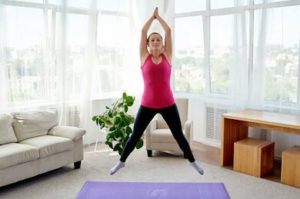
Jumping jacks
Don’t forget to do these exercises on a foam mat and give yourself break in between the exercises. Don’t overdo it on the first day, take it slowly and carefully pick up the pace of increasing your exercises.
